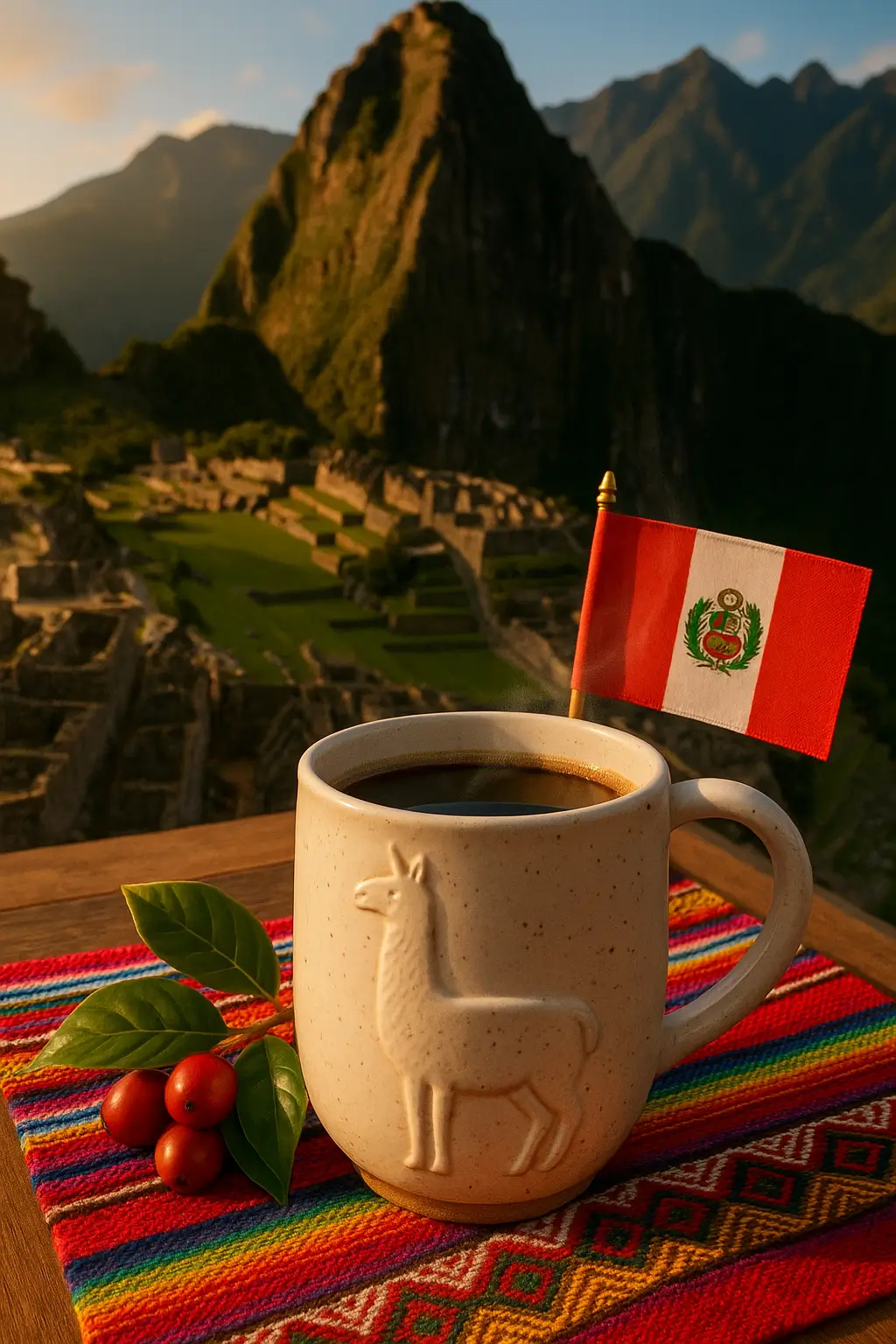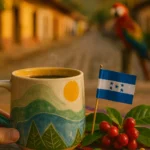Peruvian coffee is gaining recognition in the global coffee market. It’s known for its balance and complexity. This coffee offers a versatile and aromatic experience, appealing to many tastes. Let’s look at its unique flavor, diverse growing regions, and ethical legacy. We’ll explore what makes Peruvian coffee special.
- What defines Peruvian coffee: Flavor profile and characteristics
- Where does Peruvian coffee come from: Key growing regions
- How Peruvian coffee is processed: Washed vs. natural methods
- Peruvian coffee compared to other South American coffees
- The rich history and economic impact of Peruvian coffee
- What makes Peruvian coffee so special?
What defines Peruvian coffee: Flavor profile and characteristics
Peruvian coffee often has a moderate to light body. It usually brings a mild to bright acidity. You’ll find complex flavors like citrus, chocolate, caramel, nuts, and various fruits. This combination creates a balanced, pleasant cup. It works well with many brewing methods.
The body is smooth, sometimes creamy, depending on the region. Its acidity provides a fresh, lively taste without bitterness. The aroma often includes chocolate, caramel, nutty notes, and delicate floral scents.
Peruvian coffee offers a wide range of flavors. Here are some common notes you might find:
- Vibrant citrus,
- Sweet caramel,
- Rich chocolate,
- Savory nuts,
- Ripe tropical fruits,
- Honey,
- Dried fruit,
- Subtle floral accents.
Popular coffee varieties contributing to these profiles include Typica, known for delicate, fruity notes. Bourbon offers sweet, caramel-like qualities. Caturra is also common.
Some Peruvian beans have a higher caffeine content. This gives the coffee strength without much bitterness. Its balanced nature makes it ideal for espresso, pour-over, or French press. The nuanced flavors truly shine.
Where does Peruvian coffee come from: Key growing regions
Peruvian coffee grows mostly in the high Andes mountains. Consistent sunlight and moderate rain create perfect conditions. Beans thrive across wide northern, central, and southern areas. Each region adds unique flavor notes to your cup.
In Northern Peru, Cajamarca is a key region. It has a unique microclimate and high altitudes, from 900 to 1,950 meters. Cajamarca coffees are sweet with bright acidity and distinct fruity notes like red and yellow fruits. Farmers often use traditional shade-grown methods. Jaén, another important area, offers delightful citrus and chocolate flavors.
Moving to Central Peru, Junín is a major coffee-growing department. It includes the famous Chanchamayo area. This region features mountains and jungle, with an ideal average temperature of 25°C. It’s one of the most productive coffee regions. Huánuco and Pasco have mixed jungle and highland climates. Their coffees have citrus notes like oranges and mandarins, plus caramel and a smooth body. Coffee from Satipo offers a creamy body with yellow and black fruit notes.
Southern Peru also contributes many diverse coffees. Cusco is famous for its rich volcanic soils and high-altitude farms. It yields coffees with bright acidity, strong floral notes, rich sweetness, and subtle cocoa. Farmers often use sustainable practices. Near Lake Titicaca, the Puno region is known for earthy, nutty undertones. It also has well-balanced floral and tropical flavors with caramel. Ayacucho, another southern region, is celebrated for its bright acidity and distinct complexity.
The Amazon Jungle region, on the eastern slopes of the Andes, also grows Peruvian coffee. It grows under dense tree canopies, which helps preserve the rainforest. The humid, warm climate there yields coffees with strong tropical and dried fruit notes. The Andes mountains create diverse microclimates. These microclimates are key to the wide variety of aromas and flavors in Peruvian coffee. Shade-grown farming further protects biodiversity and promotes sustainable methods across these varied landscapes.
How Peruvian coffee is processed: Washed vs. natural methods
Peruvian coffee beans are primarily processed using the Washed Process, also known as Wet Processing. The Natural Process, or Dry Processing, is used less often. Each method greatly affects the coffee’s final taste and characteristics.
The Washed Process is most common in Peru. This is partly due to plenty of water and good terrain. First, coffee cherries are pulped to remove the outer skin. The beans, still covered in sticky mucilage, ferment in water tanks for 12 to 48 hours. This breaks down the mucilage. After fermentation, farmers wash the beans thoroughly to remove any residue. Then they dry them on raised beds or patios. This careful process creates a clean, bright cup with clear, vibrant flavors. It highlights the bean’s natural qualities.
The Natural Process involves drying whole coffee cherries with the beans inside. This method is less common in Peru. However, it’s becoming more popular because it creates unique flavors. The fruit sugars stay in contact with the bean during drying. This results in coffees with sweet, intensely fruity notes and a noticeably heavier body. Regardless of the method, Peruvian farmers typically hand-harvest only the ripest coffee cherries. This contributes to the overall quality of the beans.
Here is a summary of the common processing methods:
- Washed Process (Wet Processing): This method involves pulping, fermentation in water, washing, and drying. It yields a clean, vibrant, and bright cup.
- Natural Process (Dry Processing): This method involves drying whole coffee cherries with the beans inside. It results in a sweeter, fruitier coffee with a heavier body.
Peruvian coffee compared to other South American coffees
Peruvian coffee typically has a medium body, mild to bright acidity, and a versatile flavor. It often includes notes of citrus, chocolate, caramel, nuts, floral, and fruit. This makes it a distinct player among South American coffees.
How does Peruvian coffee compare to its neighbors? Brazilian coffee is a huge global producer. It tends to have a smooth, chocolatey flavor with nutty hints. It often has a heavier body and lower acidity. Colombian coffee, another well-known origin, is celebrated for its milder, balanced taste. It has strong fruity undertones and medium acidity. Colombia is known for consistent quality.
Peruvian coffee offers more variety and complexity. Its flavors range from bright and fruity to creamy with caramel and rich chocolate. This provides a diverse tasting experience. Many Peruvian coffees are produced in small batches. Many farms have organic and fair trade certifications. This shows a strong commitment to ethical sourcing and sustainability.
If you prefer a balanced, flavorful cup without extreme intensity, Peruvian coffee is a great choice. It has a multifaceted profile. It stands apart from the broader characteristics of its larger South American counterparts. You get a rich sensory experience and a connection to ethical production.
| Coffee Origin | Typical Body | Typical Acidity | Common Flavor Notes | Unique Characteristics |
|---|---|---|---|---|
| Peruvian | Medium | Mild to Bright | Citrus, chocolate, caramel, nuts, floral, fruity | Versatile, complex, often small-batch, organic, fair trade |
| Brazilian | Heavier | Lower | Smooth, chocolatey, nutty | Major global producer, consistent profile |
| Colombian | Medium | Medium | Milder, balanced, prominent fruity | Renowned for consistent quality |
The rich history and economic impact of Peruvian coffee
Peruvian coffee production began in the 1700s. Early on, it was mostly for local use, not for export. However, Peru’s coffee industry grew quickly in the late 1800s. This happened after leaf rust destroyed Arabica crops in Indonesia. European buyers then looked for new sources. The first major exports of Peruvian coffee to Europe, specifically Germany and England, started around 1887.
The early 20th century saw a boost in Peruvian coffee production. Large European investments fueled this growth. At one point, coffee made up about 60% of Peru’s exports. Large areas of land were under British control. After the World Wars, the Peruvian government began redistributing land. They transferred properties from big estates to thousands of smallholder farmers.
From the mid-20th century, coffee production shifted to these small-scale farmers. Many were indigenous growers with plots averaging two to three hectares. This change led to a strong focus on high-quality Arabica. Peru quickly gained a reputation for traditionally grown and organic production. In the 1970s, Peruvian coffee cooperatives emerged. They helped farmers with processing and exporting their harvest. However, the industry faced big challenges in the 1980s. Global prices fell, and there was political instability.
Today, coffee is very important to Peru’s economy. Peru is a top 20 global coffee producer. It ranks 5th worldwide in Arabica exports. Coffee makes up about 2% of Peru’s national economy. It involves over 110,000 mostly indigenous coffee growers across the nation. These farmers commit to quality and ethical production. Coffee provides a vital source of livelihood, employment, and income, especially in the rural Andes and eastern regions.
What makes Peruvian coffee so special?
Peruvian coffee stands out for its balanced flavor, amazing regional diversity, and strong commitment to ethical production. Its growing presence in the global market reflects its unique appeal and high quality. We encourage you to explore this exquisite coffee. Discover its rich and versatile flavors for yourself. Ready to experience the versatility and rich flavors of Peruvian coffee? Explore our curated selection of high-quality beans today!









